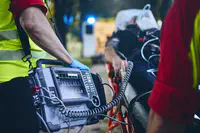How Did Fentanyl Become More Popular than Heroin?
Fentanyl’s dominance reveals a deadly shift driven by cheap production, extreme potency, and deceptive tactics by traffickers.

Over the last 150 years, there have been several different drugs described as the “most popular opioid” among drug abusers. In the late 1800s, it was morphine. In the early twentieth century and later, it was heroin. In the twenty-first Century, painkillers were intensively sought by drug users.
That’s all in the past. Now, fentanyl is the top drug being used by those addicted to opioids. In the last decade, fentanyl’s popularity has far outstripped that of OxyContin, hydrocodone, methadone, morphine, or heroin.
Fentanyl didn’t gain this position due to increased demand by users or those addicted to opioids. It earned this position because it is a cheap drug that can be wholly manufactured in a lab. No opium poppies need to be grown in Afghan fields or on the sides of Mexican mountains. The only thing needed is precursor chemicals, which drug trafficking organizations can easily obtain from unscrupulous overseas manufacturers.
It is also a powerfully potent drug. A fatal dose is around two milligrams, compared to a fatal dose of heroin which measures around 30 milligrams (depending on purity and the health of the user). This means that one pound of fentanyl will provide many, many more doses than a pound of heroin. When you are tucking away packages of fentanyl in spare tires, vehicle doors, or gas tanks, this higher potency means more money per illicit shipment.
A Quick Timeline of Opioid Popularity
Understanding the shifting sands of opioid popularity is easy if you know a little bit of this drug’s history.
Mid-1990s: Prescription opioids started being prescribed in much greater volume after pharmaceutical companies and consumer foundations promoted their use for chronic pain. Medical providers of all types were taught to consider pain as the “5th vital sign,” along with blood pressure, pulse rate, and other measures. The Food and Drug Administration helped things along by approving the opioid painkiller OxyContin from Purdue Pharma for widespread use. The FDA failed to realize that Purdue committed fraud by claiming that the drug had little addictive potential. Prior to this date, doctors were hesitant to prescribe opioids for any lasting pain because of the risk of misuse and addiction.
2010: OxyContin and Vicodin were the two most popular prescription opioids among those who abused opioids. Then Purdue Pharma announced that they had reformulated OxyContin so it was harder to abuse. As the new pills were distributed, people addicted to OxyContin very often migrated to heroin. This street drug was cheaper and easier to get (no doctor visit required). Up to this time, heroin overdose rates had been low and stable. After this change, heroin overdose deaths spiked because of the unpredictable potency of heroin supplies.
At roughly the same time, heroin delivery systems shifted to accommodate people in the suburbs and small towns who had become addicted to their pills and now needed heroin. Instead of having to drive to inner city neighborhoods to score heroin, drug dealers would deliver heroin to them wherever they were.
2012: The very first signs that fentanyl had arrived in America occurred in the fall of 2012 in Dayton, Ohio. A white powder seized in that town did not test positive for heroin but rather for fentanyl. Until this time, any fentanyl that was being abused was almost always a medical drug diverted from hospitals or other medical facilities. This new supply of fentanyl was illicitly manufactured in overseas labs.
2015: By January 2015, more than five thousand people were dying of fentanyl overdoses every twelve months.
2020: Fentanyl deaths kept increasing as more fentanyl made its way into the country, replacing more and more heroin every year. Mexican drug traffickers began working with overseas pharmaceutical companies, using their precursor chemicals to cook up fentanyl in the Western Hemisphere. They then used their long-established trafficking channels to get the drug into the U.S. By December 2020, fentanyl deaths had rocketed up to more than 57,000 in the prior twelve months.
2024: An analysis done by the CDC reported that fentanyl was present in 75% of all overdose deaths between January 2021 and December 2023.
How Drug Traffickers “Popularized” Fentanyl

To popularize this drug, drug dealers resorted to trickery. They began to mix fentanyl into not only heroin but also cocaine, methamphetamine, and MDMA (ecstasy). Anyone who used any of these drugs risked becoming quickly addicted to fentanyl. Its high potency increases the likelihood of fast addiction.
Some people have claimed that it was American demand for opioids that drove this expansion of fentanyl. This opinion is refuted by Dr. Dan Ciccarone of the University of California San Francisco. In 2019, he wrote:
“Ethnographic research with persons who use heroin confirm that the introduction of [fentanyl adulterated heroin] has been unexpected and unsettling, that fentanyl was not a demand-driven phenomenon and that there is a range of desirability for [fentanyl adulterated heroin] from abhorrence and avoidance through acceptance to enthusiasm. Those who favor fentanyl are nevertheless hampered from choosing it in the market place by its concealed identity as ‘heroin’ or counterfeit brand name pills.”*
(*Ethnographic: scientific study of people and cultures along with their customs and habits)
What Can We Conclude About Fentanyl’s Popularity?
Drug dealers want customers. They don’t care if their customers die. There are always more customers.
A report from the Department of Homeland Security summarizes the attitude of drug traffickers:
“They don’t care about the people using and addicted to drugs; instead, they profit from their victims’ dependency. The millions of dollars drug smugglers rake in by selling illegal drugs enriches the transnational criminal organizations responsible that produce and smuggle them into our country. The proceeds also fund other crimes, like money laundering, weapons trafficking and corruption.”
What Should You Do If Fentanyl Invades Your Life?
What if a loved one is using fentanyl? Or any opioid or addictive substance?
Act immediately. With the volume of fentanyl moving through America, there is no time to waste. Any day, any dose of illicit drugs can be deadly. Find an effective drug rehabilitation program. Intervene in your loved one’s drug usage. Yes, this can be a frustrating and difficult task, but that is why professional interventionists exist—to break through that person’s barriers.
Learn the signs of fentanyl addiction so you know when to take action.
About the Narconon Drug Rehab Program:
For nearly 60 years, the innovative Narconon program has enabled tens of thousands of people around the world to recover from addiction. Those who seek a long-term residential program may have already tried programs that failed them. For that reason, many people now want to find a holistic rehab that can eliminate the revolving door of drug treatment.
The Narconon program not only addresses the debilitating effects of drug abuse on the mind and body but also resolves why a person turned to drugs in the first place. Their recovery starts with a step that combines vitamins, minerals, exercise and time in a low-heat sauna that helps rid the body of accumulated drug residues. This is followed by special exercises that get each person to leave the past behind and move into the present. Each person then receives life skills training so they know how to make sober decisions and enjoy productive lives.
Narconon Is a Different Kind of Recovery Program
It’s not a Twelve Step program, nor is it a 28-day program that is so popular with many rehabs. There are no substitute medications given. Here, there is a solution for addiction that eliminates the need to consider that a person will be an addict for life. When a person graduates from the Narconon drug rehab program, they have been given tools to help them find lasting sobriety once they go home. When you need help for someone with a heroin addiction or fentanyl addiction, learn why this holistic program could be the last program your loved one ever needs.
Sources:
- “Why fentanyl is deadlier than heroin, in a single photo.” Stat News, 2016. Stat News
- “The Opioid Epidemic in the United States.” State Health Access Data Assistance Center, 2022. SHADAC
- “Opioids and a Crisis of Unintended Consequences.” RAND Corporation, 2019. RAND
- “Author Recounts How Opioids Took Hold in America.” NIH Record, 2018. NIH Record
- “Fentanyl: The Most Dangerous Illegal Drug in America.” RAND Corporation, 2020. RAND
- “Provisional Drug Overdose Death Counts.” Centers for Disease Control and Prevention, 2024. CDC
- “Fentanyl Flow in the United States.” Drug Enforcement Administration, 2020. DEA
- “Detection of Illegally Manufactured Fentanyls and Carfentanil in Drug Overdose Deaths — United States, 2021–2024.” Centers for Disease Control and Prevention, 2024. CDC
- “Fentanyl DrugFacts.” National Institute on Drug Abuse, 2021. NIDA
- “The Triple Wave Epidemic: Supply and Demand Drivers of the US Opioid Overdose Crisis.” National Library of Medicine, 2020. NLM
- “Narcotics Smuggling.” Homeland Security Investigations, 2024. DHS
- “Signs and Symptoms of Addiction to Fentanyl and Its Analogs.” NarcononUS.org, 2024. NarcononUS.org
- “Heroin Addiction Information & Resources.” NarcononUS.org, 2024. NarcononUS.org
- “Fentanyl Addiction Information & Resources.” NarcononUS.org, 2024. NarcononUS.org






 ®
®